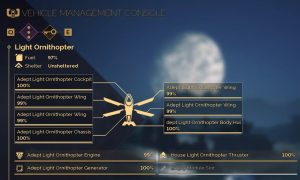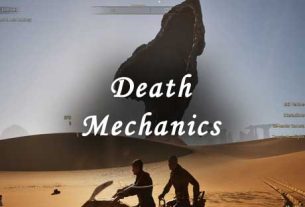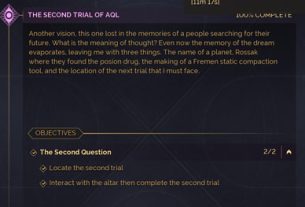Survival in Dune: Awakening isn’t just about managing your hydration and dodging sandworms! It’s also about having the right vehicle to traverse the dangerous landscapes of Arrakis. From what we’ve seen so far, the Vehicle Management Console plays a critical role in keeping your transport in top shape. Whether you’re piloting an Ornithopter to scout enemy territory or using it to escape a spice raid, knowing how to maintain your vehicle is key to survival. Let’s break down what we’ve learned from the interface.
The Vehicle Management Console
The Vehicle Management Console is a UI screen that allows players to monitor and maintain their vehicles. It seems to have multiple tabs, with Q and E as options to switch between them. This could mean different vehicles or more detailed sections for upgrades and repairs. For now, let’s focus on the Light Ornithopter, which appears to be one of the key vehicles in the game.
Light Ornithopter – A Vital Tool for Exploration
The Light Ornithopter is one of the vehicles available in Dune: Awakening, likely serving as a fast and nimble transport option for navigating the vast desert. From what we can see on the console, it has multiple vital stats to keep track of:
- Fuel Percentage – This determines how much longer your Ornithopter can stay airborne before needing a refuel. Running out of fuel in the middle of nowhere could mean a death sentence.
- Shelter Indicator – This might indicate whether the vehicle provides any protection from the harsh elements, possibly shielding players from sandstorms or extreme heat.
Durability & Repair System
One of the most interesting parts of the UI is the vehicle diagram, which displays each individual part and its durability (or HP value). This suggests that damage is taken on a component-by-component basis, meaning players will need to repair specific parts rather than the whole vehicle at once. Managing wear and tear will likely be crucial for long-term survival.
The key components listed include:
- Ornithopter Engine
- Ornithopter Generator
- Ornithopter Thrust
Each of these has a percentage value, which probably represents its durability or overall efficiency. If your engine or generator is heavily damaged, it might affect your speed, maneuverability, or even the ability to take off. This adds another layer of strategy—do you risk flying a half-broken Ornithopter, or do you return to base for repairs?
High Altitude Increases Fuel Consumption
A newly discovered mechanic suggests that flying at high altitudes will consume more fuel. This could mean that players will have to balance their flight paths carefully—staying too low might expose them to ground-based threats, while going too high could burn through their fuel reserves faster. This adds an interesting trade-off, especially for long-distance travel.
Empty Module Slot – Customization Potential?
Below the main components, we can see an Empty Module Slot. This could hint at customization options, such as:
- Upgraded fuel tanks for longer flight times
- Armor plating to reduce incoming damage
- Enhanced thrusters for better maneuverability
If true, this would mean that vehicles aren’t just static tools but can be modified to fit different playstyles—whether for exploration, combat, or stealth.
Final Thoughts – A Deeper Survival Experience
The Vehicle Management Console gives us an exciting glimpse into how vehicles will function in Dune: Awakening. Unlike traditional survival games where mounts and vehicles are often just a means of transportation, here they seem to be living systems that require fuel, repairs, and strategic customization. This suggests that players who invest time into maintaining their Ornithopter will have a significant edge over those who neglect it.
Personally, I can’t wait to see how deep this system goes. Will we need to scavenge for parts? Can we steal or salvage broken vehicles? How will PvP encounters affect vehicle durability? These are all questions I hope to get answers to as we get closer to launch.
For now, what do you think about the vehicle system? Would you prioritize upgrading your Ornithopter, or do you think ground vehicles might be a better choice? Drop a comment and let’s discuss!



